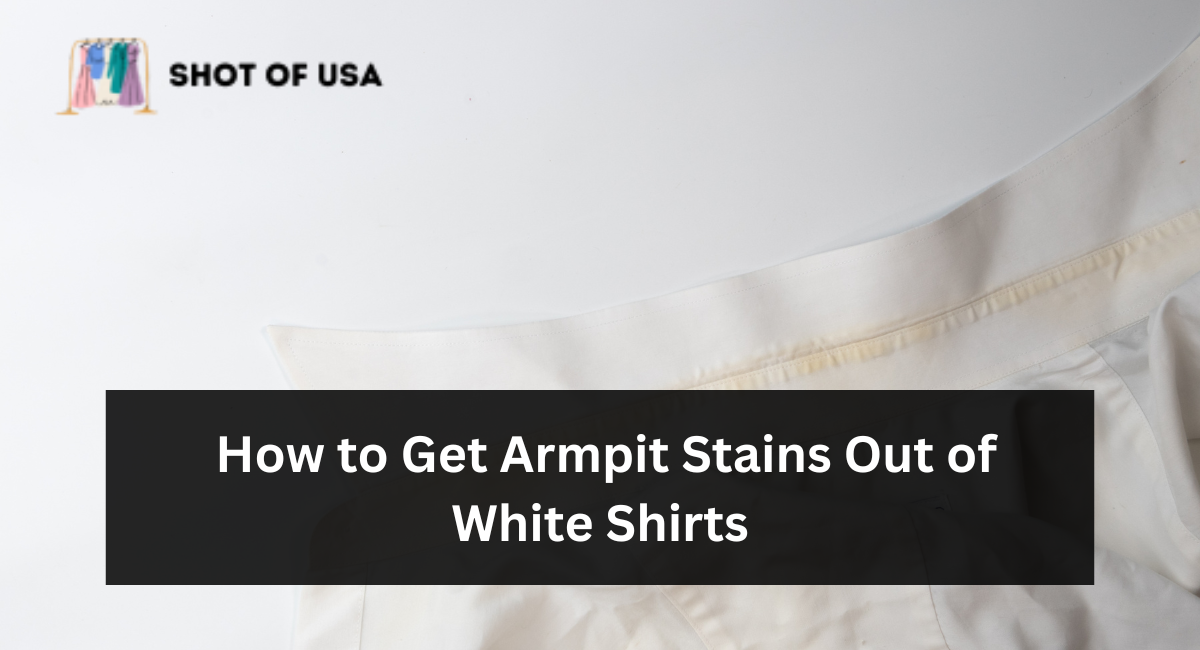Sweat stains on white shirts often form yellow spots that are difficult to eliminate due to the build-up of deodorant ingredients, sweat, and body soil on clothing fabric.
Preventing pit stains from occurring altogether is the ideal approach to getting rid of them, and using a clinical-strength antiperspirant may help. Antiperspirants help decrease nervous sweating that leads to pit stains.
Baking soda
Baking soda is an abrasive substance that works by dissolving and breaking apart molecules that cause clothing stains while neutralizing any offensive odors that arise. Add baking soda directly to your laundry load or as a pre-wash soak solution. Armpit stains from white shirts and other washable fabrics may be easily lifted.
If you don’t feel pressured to quickly get your shirt clean, wearing antiperspirant and trimming any extra hair in your underarms can help prevent sweat stains from forming by keeping bacteria-laden sweat from penetrating pores on the skin, drying and leaving yellow pit stains behind on the shirt fabric.
Alternately, you could combine four tablespoons of baking soda with 1/4 cup of warm water and apply this solution directly to the affected fabric area using your fingers or an old toothbrush to rub in. Leave this solution for an hour before cleaning off with soap and water.
An additional way to avoid sweat stains from forming is to wear an undershirt or use sweat guards (also called garment pads), which help absorb any sweat that includes. You can find them at most clothing stores or online.
Finally, lemon juice can help treat existing sweat stains on colored shirts. As this natural bleaching agent is safe for colored fabrics, test its effects on an inconspicuous area before applying it directly.
Vinegar
If yellow pit stains that won’t budge are ruining the fabric of your favorite shirt, don’t give up hope – with proper pretreatment and washing procedures, those crusty stains could soon look like they never existed!
This method also works on dark-colored clothing, though you should first test for colorfastness before proceeding. Combine equal parts baking soda and hydrogen peroxide into a paste before applying it directly to any areas with deodorant stains on garments – waiting 30 minutes between applications can help this combination of household staples tackle some of the toughest deodorant stains successfully! This combination may lift even stubborn deodorant stains; be patient as results vary!
Oxygen bleach (not chlorine bleach) is another powerful stain remover, making short work of yellow sweat stains and other kinds. When using oxygen bleach, wear rubber gloves and work in an area with sufficient ventilation. Mix powdered form of oxygen bleach with household ammonia to create a solution, pretreating any spots before washing with hotter-than-safe water settings to eliminate all traces.
Avoid placing your shirt in the dryer, as the extreme heat will set yellowing sweat stains further and make them harder to treat. Instead, air dry your garment until you can take steps to treat it again.
Oxygen bleach
Oxygen bleach can be an ideal alternative to chlorine bleach for treating sweat stains on clothing, as its color-safe formula eliminates odor and yellowing issues. Before applying stain treatments on large areas of fabric or dyed clothing, always conduct a spot test in a small area first to ensure they won’t harm either material or dyes used in its creation.
If the sweat stains on your shirt remain stubborn, try treating them with oxygen bleach pretreatment spray or liquid. This solution will effectively eradicate any remaining sweat stains while helping prevent them from reappearing when washing again. Follow the label instructions for the application of this solution.
After applying your spray or solution to the stained areas, wait approximately an hour before washing as usual. Do not dry your garment immediately because heat from a dryer could set any remaining stains and odors into place.
Avoid antiperspirant products containing aluminum to avoid yellow sweat stains on clothing by choosing deodorants that do not contain aluminum, which may lead to yellow pit stains. Instead, opt for a strong deodorant that does not contain aluminum and ensures you smell fresh all day. In addition, trimming armpit hair may help minimize excess sweat and odor as hair retains moisture and bacteria that lead to an unpleasant, sweaty armpit environment.
Ammonia
If all other options have failed, and your white shirts still look dirty, ammonia may be your solution. While it requires additional care and patience, ammonia’s powerful antibacterial qualities often produce impressive and lasting results. Mix one cup of ammonia with several cups of water and soak your clothing in this solution for at least 30 minutes before washing as usual. Also, use garment bags for delicate pieces and dehumidifiers in your closet to keep clothing dry and mold-free!
If your sweat stains are particularly stubborn, white vinegar spray may help break down their odor and stain. Baking soda mixed with hydrogen peroxide also effectively eliminates lingering odors; just be wary, as too much moisture could result in yellowing fabric damage and yellowing of garments.
While it’s ideal to prevent stains as soon as they appear, that isn’t always feasible if wearing antiperspirants with solid fragrances or strong deodorants. When this is the case, wearing a breathable undershirt could help regulate sweat production and help avoid marks or stains appearing on tops. Switch to natural or aluminum-free deodorants by applying one first thing in the morning before beginning to sweat.
Conclusion:
In conclusion, banishing armpit stains from white shirts is a triumph with the right tips. From effective stain removal methods to preventive measures, maintaining pristine white shirts is achievable. Embrace these solutions and keep your wardrobe fresh, stain-free, and ready to make a lasting impression.
